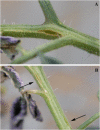Plant-like bacterial expansins play contrasting roles in two tomato vascular pathogens
- PMID: 28868644
- PMCID: PMC5835177
- DOI: 10.1111/mpp.12611
Plant-like bacterial expansins play contrasting roles in two tomato vascular pathogens
Abstract
Expansin proteins, which loosen plant cell walls, play critical roles in normal plant growth and development. The horizontal acquisition of functional plant-like expansin genes in numerous xylem-colonizing phytopathogenic bacteria suggests that bacterial expansins may also contribute to virulence. To investigate the role of bacterial expansins in plant diseases, we mutated the non-chimeric expansin genes (CmEXLX2 and RsEXLX) of two xylem-inhabiting bacterial pathogens, the Actinobacterium Clavibacter michiganensis ssp. michiganensis (Cmm) and the β-proteobacterium Ralstonia solanacearum (Rs), respectively. The Cmm ΔCmEXLX2 mutant caused increased symptom development on tomato, which was characterized by more rapid wilting, greater vascular necrosis and abundant atypical lesions on distant petioles. This increased disease severity correlated with larger in planta populations of the ΔCmEXLX2 mutant, even though the strains grew as well as the wild-type in vitro. Similarly, when inoculated onto tomato fruit, ΔCmEXLX2 caused significantly larger lesions with larger necrotic centres. In contrast, the Rs ΔRsEXLX mutant showed reduced virulence on tomato following root inoculation, but not following direct petiole inoculation, suggesting that the RsEXLX expansin contributes to early virulence at the root infection stage. Consistent with this finding, ΔRsEXLX attached to tomato seedling roots better than the wild-type Rs, which may prevent mutants from invading the plant's vasculature. These contrasting results demonstrate the diverse roles of non-chimeric bacterial expansins and highlight their importance in plant-bacterial interactions.
Keywords: Clavibacter michiganensis; Ralstonia solanacearum; bacterial plant pathogenesis; expansin; horizontal gene transfer.
© 2017 BSPP AND JOHN WILEY & SONS LTD.
Figures




Similar articles
-
The in planta transcriptome of Ralstonia solanacearum: conserved physiological and virulence strategies during bacterial wilt of tomato.mBio. 2012 Aug 31;3(4):e00114-12. doi: 10.1128/mBio.00114-12. Print 2012. mBio. 2012. PMID: 22807564 Free PMC article.
-
Ralstonia solanacearum requires PopS, an ancient AvrE-family effector, for virulence and To overcome salicylic acid-mediated defenses during tomato pathogenesis.mBio. 2013 Nov 26;4(6):e00875-13. doi: 10.1128/mBio.00875-13. mBio. 2013. PMID: 24281716 Free PMC article.
-
A Single Regulator Mediates Strategic Switching between Attachment/Spread and Growth/Virulence in the Plant Pathogen Ralstonia solanacearum.mBio. 2017 Sep 26;8(5):e00895-17. doi: 10.1128/mBio.00895-17. mBio. 2017. PMID: 28951474 Free PMC article.
-
Bacterial Canker of Tomato: Revisiting a Global and Economically Damaging Seedborne Pathogen.Plant Dis. 2021 Jun;105(6):1581-1595. doi: 10.1094/PDIS-08-20-1732-FE. Epub 2021 Apr 21. Plant Dis. 2021. PMID: 33107795 Review.
-
Global virulence regulation networks in phytopathogenic bacteria.Trends Microbiol. 2007 Aug;15(8):363-71. doi: 10.1016/j.tim.2007.06.005. Epub 2007 Jul 12. Trends Microbiol. 2007. PMID: 17627825 Review.
Cited by
-
Development of a tomato xylem-mimicking microfluidic system to study Ralstonia pseudosolanacearum biofilm formation.Front Bioeng Biotechnol. 2024 May 27;12:1395959. doi: 10.3389/fbioe.2024.1395959. eCollection 2024. Front Bioeng Biotechnol. 2024. PMID: 38860138 Free PMC article.
-
A horizontally acquired expansin gene increases virulence of the emerging plant pathogen Erwinia tracheiphila.Sci Rep. 2020 Dec 10;10(1):21743. doi: 10.1038/s41598-020-78157-w. Sci Rep. 2020. PMID: 33303810 Free PMC article.
-
Comparative Genomics and Phylogenetic Analyses Suggest Several Novel Species within the Genus Clavibacter, Including Nonpathogenic Tomato-Associated Strains.Appl Environ Microbiol. 2020 Mar 2;86(6):e02873-19. doi: 10.1128/AEM.02873-19. Print 2020 Mar 2. Appl Environ Microbiol. 2020. PMID: 31924620 Free PMC article.
-
Microbial Musings - November 2020.Microbiology (Reading). 2020 Nov;166(11):1004-1006. doi: 10.1099/mic.0.001005. Microbiology (Reading). 2020. PMID: 33252324 Free PMC article. No abstract available.
-
Identification of new Dickeya dadantii virulence factors secreted by the type 2 secretion system.PLoS One. 2022 Apr 13;17(4):e0265075. doi: 10.1371/journal.pone.0265075. eCollection 2022. PLoS One. 2022. PMID: 35417462 Free PMC article.
References
-
- Bae, C. , Han, S.W. , Song, Y.‐R. , Kim, B.‐Y. , Lee, H.‐J. , Lee, J.‐M. , Yeam, I. , Heu, S. and Oh, C.‐S. (2015) Infection processes of xylem‐colonizing pathogenic bacteria: possible explanations for the scarcity of qualitative disease resistance genes against them in crops. Theor. Appl. Genet. 128, 1219–1229. - PubMed
-
- Balaji, V. and Smart, C.D. (2012) Over‐expression of snakin‐2 and extensin‐like protein genes restricts pathogen invasiveness and enhances tolerance to Clavibacter michiganensis subsp. michiganensis in transgenic tomato (Solanum lycopersicum). Transgenic Res. 21, 23–37. - PubMed
-
- Balaji, V. , Mayrose, M. , Sherf, O. , Jacob‐Hirsch, J. , Eichenlaub, R. , Iraki, N. , Manulis‐Sasson, S. , Rechavi, G. , Barash, I. and Sessa, G. (2008) Tomato transcriptional changes in response to Clavibacter michiganensis subsp. michiganensis reveal a role for ethylene in disease development. Plant Physiol. 146, 1797–1809. - PMC - PubMed
-
- Bollard, E.G. (1960) Transport in the xylem. Annu. Rev. Plant Physiol. 11, 141–166.
-
- Boucher, C. , Barberis, P. , Trigalet, A. and Demery, D. (1985) Transposon mutagenesis of Pseudomonas solanacearum: isolation of Tn5‐induced avirulent mutants. J. Gen. Microbiol. 131, 2449–2457.
Publication types
MeSH terms
Substances
Grants and funding
LinkOut - more resources
Full Text Sources
Other Literature Sources

